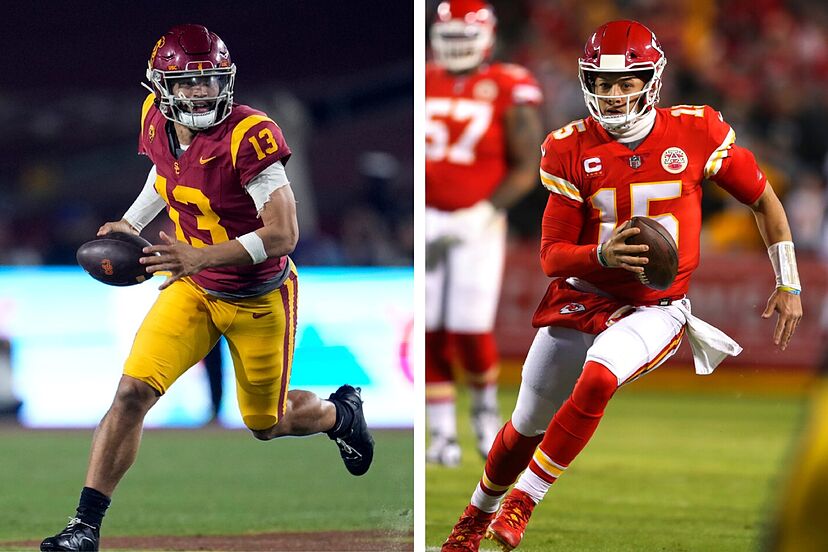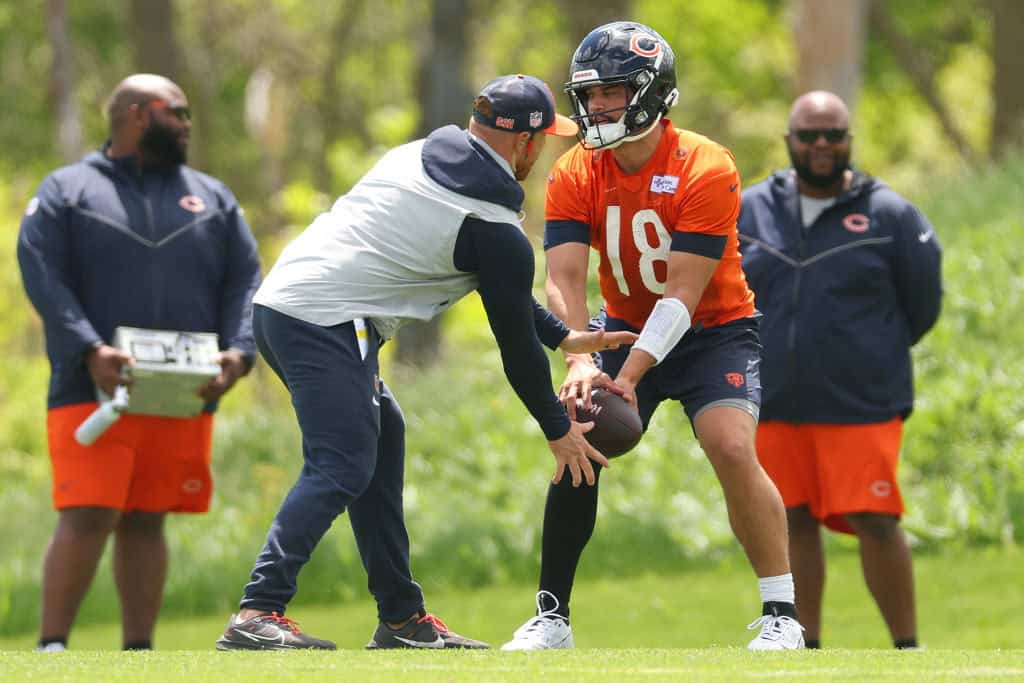
It feels like any mention of Caleb Williams during this 2024 pre-draft process triggers the eventual mention of Patrick Mahomes, doesn’t it? You would be hard-pressed to find an article, podcast, or video on the internet today that solely discusses Williams without a Mahomes nod thrown in there somewhere.
And not everyone is crazy in doing so. Watch any quarter of Williams during his last two seasons at USC, and the extravagant off-structure scampers featuring imaginative ways to get the football from point A to point B appear often. Those types of unorthodox, highlight-reel plays have become the trademark of Mahomes’ brilliance. Of course, Mahomes is much more than a quarterback who draws up plays in the sand before the snap then runs around like a wild man, but the creative element to his game sparked a revolution at the quarterback position in the modern-day NFL.
With the Williams-to-Mahomes comparison now ubiquitous, it’s time to approach this lofty comparison head on. How accurate is it? Is it nuts? Let’s jump in.
How they’re similar
For as much Williams-Mahomes comparisons as you’ll see, read, or hear, it’s now almost always followed with overt pushback. I’d like to use this part of the article to push back on that pushback. The Mahomes comps for Williams aren’t totally off-base.
On the surface, comparing any draft prospect to a future Hall of Famer, or even a Pro Bowler, is lofty. But all comparisons should just be stylistic anyway — and prospect to prospect, not prospect to NFL veteran.
With all that in mind on regarding comparisons, there is no doubting, aesthetically, Williams resembles Mahomes playing the quarterback position.
Sidearm cannon shots while rolling right (or left), seemingly awkward turned majestic scrambles away from multiple 300-pound defensive linemen, improbable completions at the last possible split-second near the sideline, and pinpoint accurate throws down the field from in the pocket — much of what Mahomes did at Texas Tech and does now for the Chiefs, we’ve seen Williams do.
And having observed Mahomes in awe the past six seasons, it feels like you’d be safe to assume he was a high-volume big-time throw producer in the Big 12. Surprisingly, he wasn’t. And neither was Williams at Oklahoma nor at USC, relatively speaking.
Almost identical. Mahomes got the slight edge in his final season, while Williams had a higher big-time throw rate in his three collegiate seasons as a starter.
Forever with the quarterback spot, holding on to the football was deemed a cardinal sin. Get it out in a hurry, right? Well, for as much as that passing methodology is still mostly viewed in a positive light, Mahomes and Josh Allen have been philosophy-changers on that front as elite quarterbacks who, yeah, they hold the ball for a long time.
And Mahomes did so in college. His average time to throw at Texas Tech — during a time in which quarterbacks were coached to basically treat the football like a game of hot potato — was 2.81 seconds, a sky-high figure for when he played in college. For context, fellow 2017 first-round draftee Deshaun Watson, who certainly wasn’t shy about utilizing his legs at Clemson, averaged 2.37 seconds to throw in his illustrious Tigers career. Massive difference.
With Williams playing college ball in the post-Mahomes world, holding the ball isn’t viewed as negatively, especially if you prove to your coaches you have the goods to escape and create. Williams earned that right early on at Oklahoma and without question in his Heisman-winning season with the Trojans in 2022.
He finished his college career with an average time to throw of 3.27 seconds. While way higher than Mahomes’ Texas Tech average, if we adjust for “era,” it’s close to the same disparity between Williams and his contemporaries as it was for Mahomes. Drake Maye’s career average time to throw at North Carolina was 2.89. Jayden Daniels was 2.84.
So both Mahomes and Williams are willing to hold the football much longer than just about everyone else who matters and we know about the improvisational traits. They surely are similarities between their games.
How they’re different
Over the past few years, we, as NFL fans, have realized that while Mahomes isn’t a freakish athletic specimen, he is incredibly difficult to sack. And, yeah, that matters probably more than you think.
As part of a 2020 FiveThirtyEight.com study that used the 2017 through 2019 seasons as its data set, Josh Hermsmeyer found that 53.4% of drives with a sack ended in a punt compared to just 35.2% of drives without a sack.
Conversely, 7.2% of drives that featured a sack ended with a touchdown run or pass, while 24.5% of drives that did not feature a sack ended in a touchdown of any kind.
Why the number dump?
Because Mahomes is basically sack-proof. And what we’ve seen with the Chiefs lately is not new behavior. Mahomes had this stellar sack-avoidance skill at Texas Tech.
Herein lies one of the key and underrated differences between Mahomes and Williams. Check the image below, note the sizable difference in location of Williams and Mahomes, as prospects.
Mahomes actually saw significantly more pressured dropbacks per game during his Texas Tech career than Williams but his pressure-to-sack rate was right around 12%. Williams was pressured on almost exactly 12 dropbacks per contest at Oklahoma and USC yet had a much higher pressure-to-sack rate of close to 20%.
What this says to me is — Mahomes is an underrated athlete, and Williams might be overrated in that increasingly vital area.
Beyond that, this is strictly just feel from me — I got the sense Williams tried to do too much Mahomesing in 2023 after drawing the comparisons the year before. He went from completing just over 51% of his attempts while under pressure at 8.6 yards per attempt with 14 touchdowns and zero interceptions the season he won the Heisman to 47% completion, at 7.2 yards per attempt with eight touchdowns and four picks under pressure last year.
Again, this is just feel — Williams looked like he was pressing too much, particularly when pressure mounted.
Lastly regarding how they’re different, and this is vital — Williams does not have Mahomes’ arm strength. Yes, comparable arm talent (which, to me, is the ability to make throws from different angles/platforms etc), but not pure throwing power. For being just over 6-foot, Williams’ arm is clearly above-average by today’s NFL standards. At times, it might even be top 10.
Mahomes arguably has the strongest arm in football. That goes for deep-ball ability and instances when he needs to crank the velocity on, say, a tight-window throw over the middle between two defensive backs. Williams isn’t to Mahomes’ level there.
Mahomes took sacks at a much lower rate and had/has a stronger arm. Those are two key elements — one really a trait more than anything — in which, as prospects, Mahomes and Williams are noticeably different.
Conclusion
Stylistically, Mahomes is probably the only genuine comparison for Williams. The way he can extend plays seemingly into next week is pretty special. Also like Mahomes, Williams is a darn-good pocket passer too with plus accuracy to all levels.
However, with those Mahomesian tendencies come more sacks for Williams than they did for the now three-time Super Bowl-winning quarterback when he was a prospect. That difference has a direct impact on offensive success.
And despite boasting a strong arm for his size and for the collegiate game, Williams isn’t as powerful of a passer as Mahomes was in college. With how much zone is being played in the NFL today, with the entire back seven staring at the quarterback, ready to pounce on a throw or explode into a throwing lane, arm strength has never been more important.
Therefore, Williams absolutely has Mahomes-esque qualities as a passer, so I don’t hate the comparisons from that perspective. He’s just doesn’t have them to Mahomes’ level, which is where the comparisons fall short.



Be the first to comment